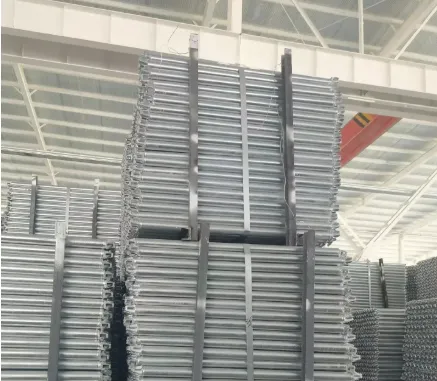
New Building Scaffolding System: Technological Innovation and Application Prospects of Scaffolding
In the field of construction engineering, scaffolding, as a temporary support structure, directly affects construction efficiency and quality in terms of safety, convenience, and economy. With the continuous advancement of technology, the limitations of traditional scaffolding systems are gradually emerging. In recent years, a new type of construction scaffolding system called "Scaffolding" has emerged, bringing significant improvements in safety, efficiency, and sustainability. This article will explore the technological innovations of the Scaffolding system and its application prospects in the future field of architecture.

Traditional scaffolding usually uses steel pipe fasteners for connection, which makes the construction process cumbersome, time-consuming, and labor-intensive, and safety depends on the standardization of manual operation. The scaffold platform system greatly simplifies the construction process through modular design and standardized production. Its main feature is the use of high-strength materials such as high-strength steel or aluminum alloy, combined with precision connectors, to achieve fast and safe assembly and disassembly. The modular design enables the Scaffolding system to flexibly adapt to different building structures and construction needs, providing reliable support platforms for complex irregular structures and vertical facades of high-rise buildings.
In terms of security, the Scaffolding system adopts multiple security protection mechanisms
For example, self-locking connectors can effectively prevent accidental loosening and improve the stability of the overall structure. In addition, some advanced rolling scaffold systems are equipped with intelligent monitoring systems that monitor key parameters such as load-bearing capacity and inclination in real time. Once the safety threshold is exceeded, an alarm will be issued to effectively prevent safety accidents from occurring. Compared with traditional scaffolding, the Scaffolding system fully considers safety factors in the design and manufacturing process, significantly reducing the risk of human operation errors.
In addition to safety, the Scaffolding system also has significant advantages in efficiency
The modular design and fast connection method greatly shorten the time of construction and disassembly, and reduce labor costs. Some A frame scaffold systems are also equipped with electric lifting platforms, which facilitate the vertical transportation of construction personnel and materials, further improving construction efficiency. In large-scale projects, this efficiency improvement is particularly significant, which can effectively shorten the construction period and reduce overall costs.
More importantly, the Scaffolding system has also demonstrated advantages in terms of sustainability
The materials used usually have a high recycling rate, which can reduce the generation of construction waste. Meanwhile, modular design also facilitates reuse and reduces resource consumption. In today's era of promoting green environmental protection, the Scaffolding system undoubtedly aligns more with the concept of sustainable development.
Looking ahead to the future, with the continuous development of building technology, the scaffolding system will be applied in more fields
On the one hand, with the further integration of intelligent technology, the access scaffolding system will become more intelligent, capable of remote monitoring, automatic adjustment, and other functions, further improving security and efficiency. On the other hand, with the continuous emergence of new materials, the Scaffolding system will adopt lighter and stronger materials to adapt to higher and more complex building structures. It can be foreseen that the scaffolding system will become an indispensable and important component of future construction projects, bringing safer, more efficient, and sustainable development to the construction industry.
In summary, as a new type of construction scaffolding system, Scaffolding is superior to traditional scaffolding in terms of safety, efficiency, and sustainability due to its modular design, high-strength materials, multiple safety protection mechanisms, and efficient construction methods. With the continuous advancement of technology and the expansion of application fields, the Scaffolding system will undoubtedly play a more important role in future construction projects.
Scaffolding FAQs
What is the essential difference between this scaffolding and traditional steel pipe clip scaffolding?
Modular design: using standardized connection nodes (such as buckle/wedge buckle), installation efficiency is increased by 3 times
Material upgrade: Use high-strength aluminum alloy (density 2.7g/cm ³) or galvanized steel (with a lifespan of up to 15 years)
Intelligent integration: Built in stress sensor for real-time monitoring of load (accuracy ± 2%), warning through IoT platform
What are the breakthroughs in the core security performance of the Scaffolding system?
Anti fall system: integrated differential self-locking device (response time<0.2 seconds) and anti overturning guide rail
Node strength: Wedge joint tensile pull force ≥ 20kN (traditional fasteners only have 8kN)
Stability control: Adjustable hydraulic base for adaptive ± 5 ° slope (traditional scaffolding requires pad adjustment)
How does Scaffolding achieve fast assembly and disassembly? What is the impact on the construction progress?
Tool free installation: patented quick release mechanism (such as spring pin) enables single-layer installation time to be less than 15 minutes
Mechanized operation: equipped with a self-propelled lifting platform (with an efficiency of 200 square meters per shift)
Construction period comparison: The overall construction period of the 30 story building's exterior frame has been shortened by 40% (from 60 days to 36 days)
What are the innovations of Scaffolding in green construction?
Material cycle: 95% of components can be reused (traditional steel pipe loss rate of 30%)
Low carbon technology: zero welding during assembly process (reducing VOCs emissions)
Photovoltaic integration: Barrier embedded with flexible solar panels (daily power generation of 2kWh/10 linear meters)
How can BIM technology empower the full process management of Scaffolding?
Digital twin: high-precision point cloud model generated by laser scanning (error<3mm)
Intelligent scheduling: Optimizing component turnover paths based on algorithms (reducing transportation costs by 25%)
Digital acceptance: Compliance of AR glasses automatic recognition node installation (100% coverage of testing items)
-
The Impact of Weather Conditions on Scaffold Platform PerformanceNewsAug.01,2025
-
The Fundamental Role of Steel Keel in Building StructuresNewsAug.01,2025
-
The Advantages of Aluminium Scaffolding for Sale in the Construction MarketNewsAug.01,2025
-
Supply Chain Optimization in Joist Reinforcement Plate ProductionNewsAug.01,2025
-
Material Grades and Their Significance in Column Rebar SelectionNewsAug.01,2025
-
How to Select the Right Timber Steel for Structural ApplicationsNewsAug.01,2025
-
The Importance of Reinforcement Bar in ConstructionNewsJul.11,2025










